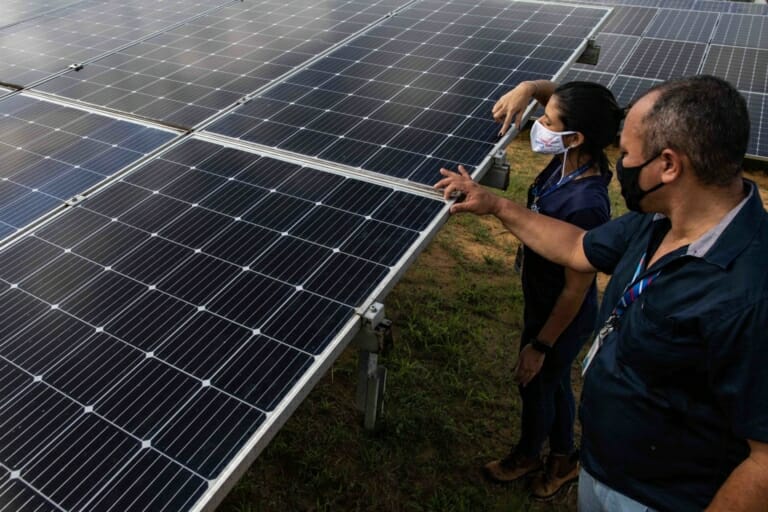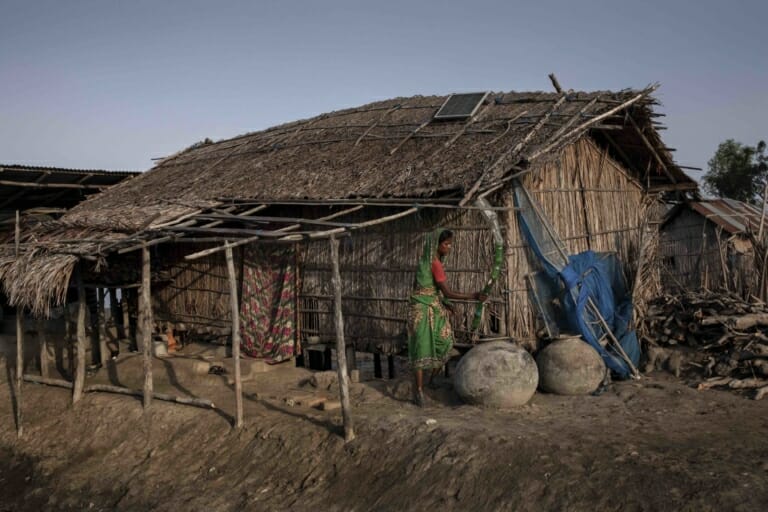The International Monetary Fund (IMF) annually assesses the economic health of its 190 member countries, making recommendations to address macroeconomic and financial challenges through surveillance processes referred to as Article IV surveillance.
On May 25, the IMF — charged with securing economic stability and effective operation of the international monetary system — completed a long-awaited review of its Article IV surveillance processes, the Comprehensive Surveillance Review. Recognizing the potential for climate change to reduce productivity or growth prospects and increase financial instability, the review evaluated how climate change should be factored into Article IV surveillance.
To date, the IMF has considered climate-related risks and policies in Article IV surveillance on an ad hoc and infrequent basis. The review concluded that climate change, including climate mitigation, adaptation and transition risk management, should in many cases be incorporated into Article IVs, but it stopped short of requiring coverage of these topics in a systematic way.
The IMF warns that the impacts of climate change and costs of meaningful climate action will be substantial and unevenly distributed across and within countries. By failing to take a mandatory and systematic approach to including climate in surveillance, however, the IMF constrains its own ability to identify and evaluate significant risks to financial and economic stability within countries and globally.
What Are Article IVs and Why do They Matter?
Through Article IV surveillance, the IMF monitors the economic and financial situation of its members on a regular basis and in consultation with national authorities and other domestic stakeholders. It uses this monitoring function to identify possible risks to the macroeconomic stability of a country or of the global economy, and to recommend ways to avoid or minimize those risks. The IMF’s surveillance function is central to its role, which is to ensure the stability of the international monetary system.
These regular health checks matter. They have the potential to influence member countries’ economic policies at the national level. Bilateral surveillance offers the IMF the opportunity to engage with country officials, including ministries of finance and central banks, on key areas of policy and to recommend reorienting the trajectory if deemed necessary.
Additionally, Article IV reports have an important signaling effect for other stakeholders in the international community — including investors, creditors, donors and others — who view IMF Article IV reports as an authoritative source of information on the economic and financial prospects of countries around the world.
Given the important role of Article IV reports, it is critical that they reflect and respond to climate-related risks in a comprehensive and systematic way.

What Did the Surveillance Review Say About Climate?
Until recently, the IMF only considered climate-related risks and policies in Article IV surveillance on an ad hoc and relatively infrequent basis. With the 2021 Comprehensive Surveillance Review, the IMF took a significant step forward by exploring the need to cover climate in surveillance reports in a more systematic way.
In its bilateral surveillance activities, the IMF only has a mandate to cover topics or policies that are considered “macro-critical” — an issue that significantly affects a country’s current or future balance of payments and domestic stability. In light of this requirement, the review grappled with questions of whether and when climate-related issues, including climate adaptation, transition risks, and mitigation are macro-critical.
1. Climate Change Adaptation
The review concluded that climate change adaptation is macro-critical, fitting squarely within the IMF’s surveillance mandate and is potentially relevant for many of the IMF’s 190 member countries. Moreover, the IMF is well placed to advise countries on climate-related policies aimed at building financial resilience because such policies often fall within the IMF’s traditional realm of expertise. Measures designed to help climate-vulnerable countries build up fiscal buffers, for example, align well with the types of macroeconomic analysis the IMF routinely conducts. Some adaptation policies, such as policies aimed at building physical resilience, may be outside of the IMF’s core areas of expertise — for these it can rely on other institutions’ resources and know-how.
2. Climate-related Transition Risks
The institution reached similar conclusions on transition risks and policies to manage these risks. As economies decarbonize, certain sectors are likely to face dramatic shifts in asset values or in the cost of doing business; this transition has the potential to pose significant risks — particularly if it occurs rapidly and in an uncoordinated manner. The surveillance review found that this category of risks falls within the IMF’s surveillance mandate and are potentially relevant to nearly all its members. As with adaptation, the IMF is well suited to advise on policies for managing transition risks, and it underlines that transition risk management will likely entail painful adjustments that need to be undertaken to transform entire sectors of the economy.
In a way, the IMF and other international institutions already have a track record of identifying and cautioning against these types of risk, as they have long emphasized the need for economies to eliminate fossil fuel subsidies and diversify away from fossil fuels to mitigate the adverse impacts of international price fluctuations on a country’s revenue. They will now also need to consider potential distributional impacts on labor markets and equity considerations as economies transition to low carbon development pathways.
3. Climate Mitigation
The review’s conclusions were less straightforward when it comes to climate change mitigation. It found that the IMF’s surveillance mandate can extend to climate change mitigation, but only where an individual country’s mitigation policies (or lack thereof) would have significant spillover effects for the international monetary system. Based on this finding, the IMF will strongly encourage coverage of mitigation in Article IVs at least every three years for the 20 largest emitters (based on current greenhouse gas emissions).
For others, inclusion of mitigation will be encouraged but not expected. Article IV reports that include mitigation will evaluate the adequacy of a country’s mitigation policies to contain negative spillover, including not only carbon-pricing based mitigation policies but a wide range of policy approaches for reducing GHG emissions.

What’s Missing?
The Comprehensive Surveillance Review is a positive first step and lays the groundwork as the IMF further develops its surveillance guidance and climate strategy going forward. More is needed to systematically integrate climate change into Article IV surveillance. This could include:
First, clarifying when adaptation and transition risks must be addressed.
Despite acknowledging the potential importance and relevance of climate adaptation and transition risks to much of its membership, the review does not set out clear guidelines specifying when and how these topics will be covered in country-level Article IV reports. Forthcoming guidance on implementation of the surveillance review’s recommendations should establish clear criteria, indicators or thresholds for when these topics must be addressed. This would help avoid continuation of a current ad hoc approach, which leaves discretion in the hands of individual mission chiefs and country officials.
In-depth assessments of climate-related risks in Article IV reports could alter the financial prospects of climate-vulnerable countries, raising potential equity concerns that the IMF will also need to consider. Such concerns highlight the need for development banks and bilateral donors to complement the IMF’s surveillance by providing public finance to help countries invest in resilience.
Second, acknowledging that mitigation risks may be better assessed dynamically.
Identifying those countries whose approach to mitigation has the potential to “significantly influence the effective operation of the international monetary system, for example, by undermining global economic and financial stability,” — the standard established in a 2012 IMF decision — is not straightforward. Acknowledging practical challenges, however, focusing only on the top 20 emitters based on current GHG emissions may be overly simplistic. For instance, this approach may exclude large, fast growing economies whose emissions are on the rise, thus requiring a more dynamic assessment over time. As with the recommendations for adaptation and transition risk, simply “encouraging” inclusion of climate mitigation for selected countries allows for considerable discretion, which lacks the rigor of a more systematic and consistent approach.
In addition to taking a more comprehensive approach to inclusion of mitigation in Article IV reports, surveillance guidance should clarify how coverage of mitigation will address equity issues and a just transition.
Finally, given the potential cross-sectoral and cross-border spillovers, integrating climate risks into the global risk assessment toolkit.
The IMF warns that the costs of meaningful action to combat the effects of climate change will be uneven and may have non-linear effects on GDP levels depending on geographic characteristics. But by adopting a case-by-case approach to including climate and failing to make its inclusion mandatory in specified cases, the IMF is constraining its own analysis of the risks to the global economy. Indeed, the lack of systematic focus appears incongruous with the risks climate poses to global economic and financial stability. For instance, failure on the part of large emitters to adopt appropriate mitigation policies could produce more severe extreme weather events, which could, in turn, increase financial fragilities or external account imbalances in other countries around the globe.
The main IMF flagship reports (World Economic Outlook, the Fiscal Monitor and the Global Financial Stability Report) could integrate these issues by identifying climate-related vulnerabilities that could spill over across borders and would call for international cooperation. This would help support the direction that the IMF is taking in the surveillance review by highlighting its approach to climate change, while drawing the attention of policy makers worldwide.
For example, flagship reports could include and present evidence from the new Climate Change Indicators Dashboard in a compelling way and build on this evidence, such that climate is given a weight, which is commensurate with the risks to global stability.
In recent months, the IMF has signaled that it plans to develop its analysis of the economic impact of climate change and strengthen its approach to climate-related risks. The development of detailed surveillance guidance over the coming months and a broader climate strategy offer an opportunity for the IMF to put words to action and integrate climate into core IMF operations in ways that could meaningfully benefit its member countries.
WRI’s Sustainable Finance Center is conducting a preliminary study on systematic incorporation of climate change in IMF Article IV surveillance. The results of this study will be published in a working paper by the end of the year.
— —
About the authors: Valerie Laxton is a Senior Associate in WRI’s Finance Center, where she leads the Center’s work to promote climate ambition at development finance institutions, including multilateral development banks, national development banks, and the International Monetary Fund. Lauren Sidner is an Associate in the Sustainable Finance Center. She focuses on development finance institutions and disaster risk finance.
Editor’s Note: The opinions expressed here by Impakter.com columnists or contributors are their own, not those of Impakter.com. — In the Featured Photo: Managing Director of the International Monetary Fund Kristalina Georgieva speaks at the October 18th plenary session of the Annual Meetings in Washington, DC. Featured Photo Credit: World Bank / Simone D. McCourtie.










